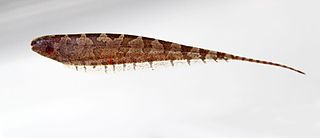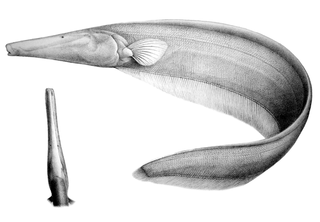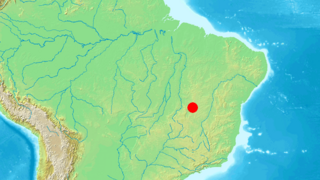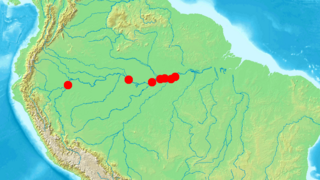
The Gymnotiformes are an order of teleost bony fishes commonly known as Neotropical knifefish or South American knifefish. They have long bodies and swim using undulations of their elongated anal fin. Found almost exclusively in fresh water, these mostly nocturnal fish are capable of producing electric fields to detect prey, for navigation, communication, and, in the case of the electric eel, attack and defense. A few species are familiar to the aquarium trade, such as the black ghost knifefish, the glass knifefish, and the banded knifefish.

The naked-back knifefishes are a family (Gymnotidae) of knifefishes found only in fresh waters of Central America and South America. All have organs adapted to electroreception. The family has about 43 valid species in two genera. These fish are nocturnal and mostly occur in quiet waters from deep rivers to swamps. In strongly flowing waters, they may bury themselves.

The ghost knifefishes are a family, Apteronotidae, of ray-finned fishes in the order Gymnotiformes. These fish are native to Panama and South America. They inhabit a wide range of freshwater habitats, but more than half the species in the family are found deep in rivers where there is little or no light.
This glossary of ichthyology is a list of definitions of terms and concepts used in ichthyology, the study of fishes.

Glass knifefishes are fishes in the family Sternopygidae in the order Gymnotiformes. Species are also known as rattail knifefishes.

The Hypopomidae are a family of fishes in the order Gymnotiformes known as the bluntnose knifefish. They may also be called grass or leaf knifefishes. These electric fish are not often eaten, of little commercial importance, rarely kept as aquarium fish, and poorly studied; however, species in this family may constitute a significant fraction of the biomass in the areas they inhabit.
Sternarchogiton nattereri is a species of weakly electric knifefish in the family Apteronotidae. It is native to the Amazon River system and feeds on sponges. Unlike other members of the genus Sternarchogiton, there is pronounced sexual dimorphism in S. nattereri, with reproductively mature males developing strong external teeth on tips of their jaws. These males are so different from the females and juveniles that they were thought to be a different genus and species, the "tooth-lip knifefish" Oedemognathus exodon, for over 40 years.

Orthosternarchus tamandua, the tamandua knifefish, is a species of weakly electric knifefish in the family Apteronotidae, native to the deep river channels of the Amazon basin. This species is characterized by its whitish-pink color, long tubular snout, long dorsal appendage, and tiny, bilaterally asymmetrical eyes.
Sternarchogiton labiatus is a species of weakly electric knifefish in the family Apteronotidae. Its species name labiatus comes from the Latin labium, meaning "lip", referring to a distinctive three-lobed structure on its lower lips. S. labiatus is only known from the Tefé River, at a depth of 6–14 m (20–46 ft), and from the lower Rio Negro, in the Amazon River basin. They have been captured from both whitewater and blackwater habitats.
Sternarchogiton porcinum is a species of weakly electric knifefish in the family Apteronotidae. It is native to deep river channels in the Río Huallaga, Río Napo, and Río Amazonas in Peru, and in the Río Orinoco in Venezuela. Many specimens once identified as S. porcinum from the Brazilian Amazon Basin and the Venezuelan Orinoco are now known to be a different species, S. preto.

Eigenmannia vicentespelaea is a species of weakly electric knifefish in the family Sternopygidae. Native to the São Domingos karst area in central Brazil, it is the only known knifefish to exclusively inhabit caves. Measuring up to 21 cm (8.3 in) long, E. vicentespelaea can be distinguished from its relatives by its translucent body and reduced or absent eyes. As some individuals retain well-developed eyes, this fish may have colonized caves only recently in evolutionary time.

Tembeassu marauna is a species of weakly electric knifefish in the family Apteronotidae and the only member of its genus, known only from three specimens collected from the upper Paraná River, Brazil, in 1965. This fish can be identified by fleshy extensions at the tips of its upper and lower jaws, with the upper extension bearing a patch of extra teeth. The function of these unique structures is unknown, but may relate to feeding. Apparently a specialized inhabitant of deep riverine environments, T. marauna may be endangered by extensive dam construction in the upper Paraná region, if not already extinct.

Pariosternarchus amazonensis is a little-known species of weakly electric knifefish in the family Apteronotidae, and the only member of the genus Pariosternarchus. It is found in the main channel of the Amazon River in Brazil and Peru, likely near the bottom in deep, fast-moving water. This species is characterized by a wide head with a flat bottom, and very large sensory canals along the lower jaw. Like several other knifefishes found in deep river channels, it has reduced eyes, scales, and body pigmentation.
Sternarchella, the bulldog knifefish, is a genus of ghost knifefishes found at depths of 2–50 m (7–164 ft) in the main channel of large rivers in South America. Most are from the Amazon basin, but S. orthos is found both in the Amazon and Orinoco, S. orinoco is restricted to the Orinoco and S. curvioperculata restricted to the upper Paraná basin. They are often common in their habitat.

Rhamphichthys(Rhamphos = Greek for beak and Ichthys = Greek for fish) is a genus of fish that includes the South American sand knifefish. These fish are eel shaped with a distinct beak like snout which gave them their name. Like most other knifefish Rhamphichthys species have electrical organs that help them live in the murky waters of South America. Currently there are 10 recognized species of Rhamphichthys, although many changes have been made in their taxonomy since their original discovery.
Gymnotus choco, commonly known as the cuchillo, is an electric knifefish. G. choco is distinguished from its cogenerate species group by a color pattern possessing pale yellow bands oriented obliquely, wherein the interband margins are wavy or even irregular; one to three Y-shaped dark bands occur on its body's posterior section; and its pale bands do not extend above the fish's lateral line on its body's anterior two-thirds. G. choco is most similar to G. paraguensis from the Pantanal in Brazil and Paraguay. From the latter, it is distinguished by having a narrower mouth, a more cylindrical body, and a longer preanal distance.
Astyanax microschemos is a species of characid fish from Brazil. It belongs to the A. scabripinnis species complex and differs from other species outside it by having a lower number of branched anal fin rays and its shallow body depth being about 26.9-29.7 vs more than 35% of its standard length (SL). Compared to species of its own complex, it can be distinguished by the combination of its shallow body depth, and smaller interorbital width. The species name comes from the Greek mikroschemos, meaning "low stature", which refers to the shallow body depth of the animal.

Deuterodon pelecus is a species of characid fish from Brazil. It can be distinguished from other species by: its body depth ; its short and pointed snout smaller than the orbital diameter; and a reduced number of branched anal fin rays. D. pelecus also differs from members of its genus by its characteristic color pattern. It possesses a single humeral spot that is constricted to the region above the lateral line; at the same time it shows a conspicuous midlateral body stripe from opercle to the caudal fin base, an autapomorphy of this precise species. Other Deuterodon species have a humeral spot that is vertically or horizontally elongate and have the midlateral stripe becoming faint near that humeral spot. The species name is derived from the Greek pelekus, meaning "axe", referring to the pigmentation shape resulting from the adjoinment of the humeral spot with the midlateral stripe.
Humboldtichthys is an extinct genus of glass knifefishes from the Miocene Yecua Formation of Bolivia. A single species is currently recognized: Humboldtichthys kirschbaumi.
Archolaemus luciae is a species of glass knifefish endemic to Brazil where it is found in the Rio Jari, the Rio Trombetas and the Rio Tapajós basins in the eastern Amazon. Also found in the Rio Araguari. This species reaches a length of 49.7 cm (19.6 in).










